Section D
Electrical Installations
Question Bank
Q1) What are MCB’s?
Sol: MCB is a switch which automatically turns off when the current flowing through it passes the maximum allowable limit. Generally, MCB is designed to protect against over current and over temperature faults. In MCB there are two contacts one movable and other non-movable. When the current exceeds the predefined limit, a solenoid forces the moveable contact to open and the MCB turns off, thereby stopping the current from flowing in the circuits.
It mainly consists of one bi- metallic strip, one trip coil and one hand operated on-off lever. The current in MCB flows from left side of circuit to bimetallic strip further going into the current coil, moving contact and at last through right side of circuit. When circuit is overloaded the bimetallic strip is overheated.
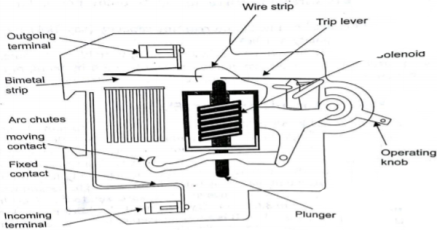
This deformation of bimetallic strip causes displacement in the latch. This displacement releases the spring through which the MCB is connected to the moving contact. This spring makes moving contact to open MCB.
The current coil or trip coil placed in such a manner that during SC faults, the MMF of that coil causes its plunger to hit the same latch point and force the latch to be displaced. Hence, the MCB will open in the same manner.
Q2) List Advantages of MCB?
Sol:
i) MCBs are replacing the re-wire able switch i.e., fuse units for low power domestic and industrial applications.
Ii) The disadvantages of fuses, like low SC interrupting capacity (say 3kA), Etc. Are overcome with high SC breaking capacity of 10kA
Iii) MCB is combination of all three functions in a wiring system like switching, overload and short circuits protection. Overload protection can be obtained by using bi-metallic strips whereas shorts circuits protection can be obtained by using solenoid
Q3) Explain Voltage-ELCB?
Sol: It consists of a relay coil; one end of that coil is connected to the metal body and other to the ground. When voltage on the equipment body rises to 50V (danger level) the current in the relay loop moves the relay contact by disconnecting the supply current and saves from electric shock.

Q4) Explain Current ELCB?
Sol: It is mostly commonly used ELCB. It consists of transformer having two primary (neutral and line wire) windings and one secondary winding. In balanced condition there is no current in secondary because the neutral wire balances the current through the phase wire.
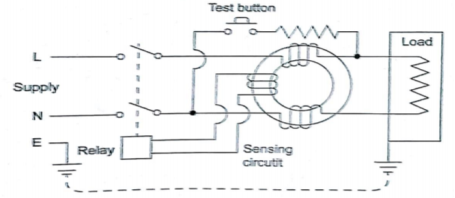
During fault a small current flow to ground causing imbalance between line and neutral currents. As a result of which current is induced in secondary winding. The sensing circuit connected to the secondary sends signal to the tripping system and the contact is tripped.
Q5) What are MCCB?
Sol: Moulded case circuits breakers are electromechanical devices which protect a circuit from over current and short circuits. They provide over current and short circuits protection for circuits ranging from 63A up to 3000 A. They are used for heavy duty applications as they have high current ratings. They provide electric feeder protection, capacitor bank protection, generator protection, welding applications, low current application that require adjustable trip setting and motor protection.
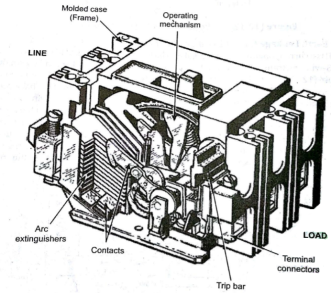
They are made up of heavy duty insulated plastic. MCCB has a bimetallic contact that expands and contacts when there is change in temperature. When current exceeds the adjustable trip value the contact gets heated and expands. The fault currents in MCCB can be interrupted immediately. Whenever a fault occurs, the extremely high current induces a magnetic field in a solenoid coil located inside the breaker – this magnetic induction trips a contact and current it interrupted
Q6) Explain types of wirings?
Sol: (I) According to the conductor material used
(a) Copper conductor cables
(b) Aluminium conductor cable
(ii) According to number of cores
(a) Singles core cable (SCC)
(b) Double core or twin core cables (DCC)
(c) Three core cables
(d) four core cables
(e) Two cores with earth continuity conductor cables
(iii) According to type of insulation
(a) Vulcanized Indian rubber (VIR) insulated wires/cables
(b) Tough rubber sheathed (TRS) or cable tyre sheathed (CTS) cables
(c) Polyvinyl chloride (PVC) cables
(b) Lead sheathed cables
(e) Weather proof cables
(f) Flexible cords and cables
(g) XLPE cables
(IV) According to the voltage at which they are manufactured
(a) Low tension (LT) cables – up to 1000V
(b) High tension (HT) cables – up to 11kV
(c) Super tension (ST) cables – from 22-33kV
(d) Extra high tension (EHT) cables – from 33-66kV
(e) Extra super voltage cables – beyond 132 kV
Q7) What is the need for earthing?
Sol:
i) To protect the operating personnel from the danger of shock.
Ii) To maintain the line voltage constant, under unbalanced load condition.
Iii) To avoid risk of fire due to earth leakage current through unwanted path.
Iv) Protection of the equipment.
v) Protection of large buildings and all machines fed from overhead lines.
Q8) Explain plate earthing?
(i) Sol: A copper plate of dimension 60cm x 60cm x 3.18 is used for earthing. The plate is buried in ground and layered with coal and salt. Then water is poured to maintain the earth’s electrode resistance below maximum value. The earth wire is bolted to the earth plate.
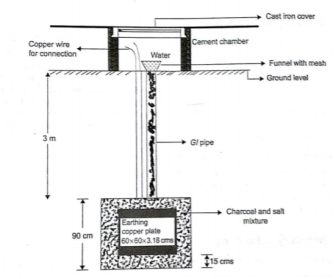
Q9) Explain Rod earthing?
(i) Sol: It is similar to pipe earthing method. A copper rod is buried upright in the earth manually or with pneumatic hammer. The length of embedded electrodes in soil reduces earth resistance to a desired level.
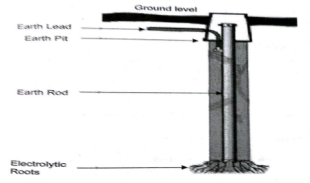
Q10) List applications of various types of earthing?
Sol: 
Measuring Instruments
Q11) Explain the construction and working of moving iron type voltmeter?
Sol: Construction
The moving element is a plate or soft iron. The plate is placed such that is moves freely in the magnetic field of stationary coil. These stationary coils are electromagnets. These magnets are temporary magnets whose field strength varies according to the amount of current passing through it. They can be used for both AC as well as DC.
Operation
These instruments use moving iron to measure the flow of current or voltages. When the iron is placed near magnetic field it is attracted towards the field. The force of attraction depends upon the strength of field.

The stationary coil of copper or aluminium wire acts as electromagnet when current passes through it. The plate when passes through this coil increases the inductance of stationary coil. The electromagnets attract the plate. The plate passes through coil from the least reluctance path. This plate experiences a repulsion due to electromagnets. The repulsion force increases the strength of the coil inductance. This happens because the inductance and reluctances are inversely proportional to each other.
One iron vane is held fixed to the coil frame and other is free to rotate, carrying with it the pointer shaft. Two irons lie in the magnetic field produced by the coil that consists of only few turns if the instrument is an ammeter or of many turns if the instrument is a voltmeter. Current in the coil induces both vanes to become magnetized and repulsion between the similarly magnetized vanes produces a proportional rotation
The moving iron instrument can be classified as
i) Repulsive moving iron instrument: It has two vanes one is fixed and the other is moving. When current passes through stationary coil the vane gets magnetized and a repulsive force is generated between them. Due to this repulsion the moving coil moves away from the fixed vane.
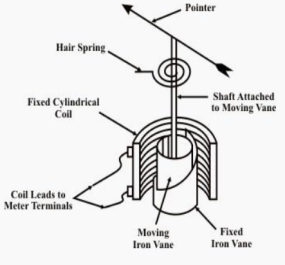
The spring coil provides controlling torque. The damping torque induced opposes the movement of the coil. These instruments are not affected by the direction of current flow.
Ii) Attractive moving iron instrument: In this the iron plate is attracted from the weaker field towards the stronger one. The stationary coil is flat and has narrow opening. The flat disc of iron core is moving element. The current through stationary coil produces the magnetic field and attracts the iron coil.
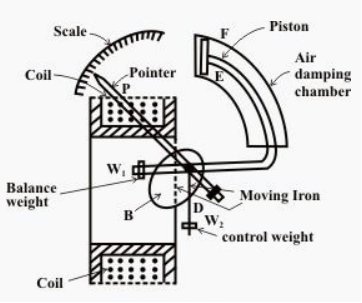
The iron plate then gets attracted from low magnetic field to high magnetic field. The strength through which the iron plate is deflected is directly proportional to the current flowing through it.
Advantages:
They are low cost instruments. They are easy to assemble. They have less friction error. They are used in both AC and DC.
Q12) Explain induction type Ammeter?
Sol: In all induction meters we have two fluxes which are produced by two different alternating currents on a metallic disc. Due to alternating fluxes there is an induced emf, the emf produced at one point (as shown in the figure given below) interacts with the alternating current of the other side resulting in the production of torque.

Let F1 =flux at point 1
F2= flux at point 2
Then
F1 = Fm1 sinwt
F2= Fm2 sin (wt-B)
B=phase difference between two fluxes.
The induced emf for both points will be
E1= - 
E2= - 
The value of eddy current at point 1 is
I1 = E1/Z = K x f x F1
The phasor is shown below

The deflection torque at point 1 will be
Td1= K x F2 x I1x cos(90-B+A) = K x F1 x (f/Z) cos(90-B+A) x F2
The deflection torque at point 2 will be
Td2= K x F1 x (f/Z) x cos(90+B+A) x F2
Total torque is
Td1- Td2 = K x F1 x F2 x (f/Z) sinB cos A
They are of two types:
i) Split phase type: It has two magnets M1 and M2 in series. The shunt resistance R is connected to M2. The current in M2 lags line current. The deflection torque is Td = φ1m φ2m sinα
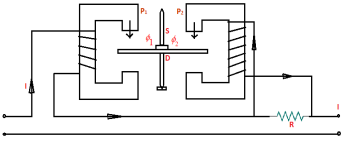
Ii) Shaded Pole Type: In this case the exciting coil is placed on poles. The current proportion to current or voltage is measured.
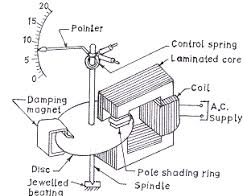
In the air gap of electromagnet aluminium disc mounted on a spindle is inserted. The spring is attached to the pointer and both are mounted on spindle. The spring provides the controlling torque.
The deflection torque is Td = φ1φ2 sinα
Q13) Explain working of moving coil type voltmeter?
Sol: It is called as Permanent magnet moving coil (PMMC). They measure only DC. This instrument measures the current through coil by angular deflection in magnetic field. A coil is placed between two permanent magnets in these types of instrument to produce magnetic field. The current carrying conductor when placed in the field experiences a force which is proportional to the amount of current through it. When the torques are balanced the moving coil stops. The angular deflection can be measured.
The deflection torque equation is given as
Td=NBldI
N: Number of turns
B: Magnetic flux density
l: length of moving coil
d: width of moving coil
I: Electric current
The below circuit extends the range of voltmeter by connecting resistance in series with the meter.
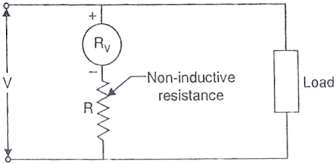
The external resistance connected will be
R= [V-V1/V1] x RV
RV: Voltmeter resistance
R: external resistance
V1: voltage across voltmeter